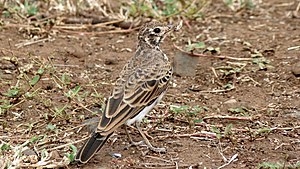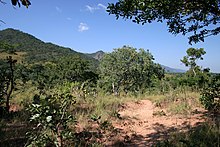Thrush Lark
| Thrush Lark | ||||||||||||
|---|---|---|---|---|---|---|---|---|---|---|---|---|

Thrush Lark |
||||||||||||
| Systematics | ||||||||||||
|
||||||||||||
| Scientific name | ||||||||||||
| Pinarocorys nigricans | ||||||||||||
| ( Sundevall , 1850) |
The thrush lark ( Pinarocorys nigricans ) is a species from the lark family. Its size corresponds to that of the skylark and its color is reminiscent of a song thrush . The distribution area of the Drossellerche is in the south of Africa. There are two subspecies.
The IUCN classifies the thrush larch as not endangered ( least concern ).
features
The Drossellerche reaches a body length of about 18 to 19 centimeters, of which 7 to 8 centimeters are on the tail. The beak measures 1.6 to 2 centimeters from the beak. Drosselchen weigh between 30 and 46 grams. There is a slight gender dimorphism.
The adult male is dark brown on the upper side of the body, only individual feathers have a yellow-brownish to whitish feather edge. The over-eye stripe and the region around the eye are yellowish brown to whitish. The light yellow-brown cheeks and ear covers are framed in black-brown. The chin and throat are white, the slightly darker chest and the goiter are longitudinally streaked black-brown. The rest of the underside of the body is white. The dark brown hand and arm wings are dark brown with rust-brown lined outer flags and individual whitish tip spots. The tail plumage is black-brown with very narrow whitish to red-brownish borders. The beak is horn-colored, the iris is brown.
Females are similar to males in terms of their coloration, but are overall somewhat lighter on the upper side of the body, the facial pattern is more dull.
Possible confusion
Due to its size and plumage, the thrush lark should not be confused with any other species of lark. However, its appearance is reminiscent of the acacia thrush ( Turdus litsitsirupa ), which occurs in the distribution area of the thrush lark. Compared to her, the thrush lark has a darker back, a shorter and stronger beak, and shorter legs. As is typical for larks, the lark puts one leg in front of the other without both feet leaving the ground at the same time. Similar to the acacia lark, the thrush lark sits more often in bushes and on trees.
Distribution area and habitat

The distribution area of the Drossellerche is in the south of Africa. It extends from Namibia, Angola and Zaire to the north of Zambia and western Tanzania. It is a stand , stroke and migratory bird that roams far. Outside of the breeding season, in the period from October to May or June, thrush celeriac can also occasionally be found south of 15 ° S. It then also reaches the northeast of the South African Republic.
The habitat is the Miombo , a vast forest type of savanna , savannah, thorn steppes and burned areas.
Way of life
Outside of the breeding season, thrushes form groups of up to 100 individuals. They feed mainly on insects, but also consume seeds.
Like most larks, the male also shows a singing flight. It rises slowly in a spiral to a height of about 30 meters above the ground and then flutters and flaps its wings down onto a bush or tree.
Subspecies
There are two subspecies:
- P. n. Nigricans - ( Sundevall , 1850) : breeding occurrences from the southeast of the Democratic Republic of the Congo, the northwest of Zambia to the southwest of Tanzania.
- P. n. Occidentis - Clancey , 1968 : Brood occurrences from the southwest of the Democratic Republic to the north of Angola
literature
- Rudolf Pätzold : The larks of the world . Westarp Sciences, Magdeburg 1994, ISBN 3-89432-422-8 .
- Rudolf Pätzold: Compendium of Larks. All the larks on earth. Jan-Schimkat-Medienpublikation, Dresden 2003, ISBN 3-00-011219-7 .
Web links
- Song of the Drossellerche on Xeno-Canto
- Pinarocorys nigricans in the endangered Red List species the IUCN 2016 Posted by: BirdLife International, 2016. Retrieved on 5 March 2017th
Single receipts
- ↑ a b Pätzold: Compendium of Larks . P. 129.
- ↑ Pinarocorys nigricans in the endangered Red List species the IUCN 2016 Posted by: BirdLife International, 2016. Retrieved on 5 March 2017th
- ^ Pätzold: Compendium of Larks . P. 130.
- ^ IOC World Bird List 6.4 . In: IOC World Bird List Datasets . September. doi : 10.14344 / ioc.ml.6.4 .
